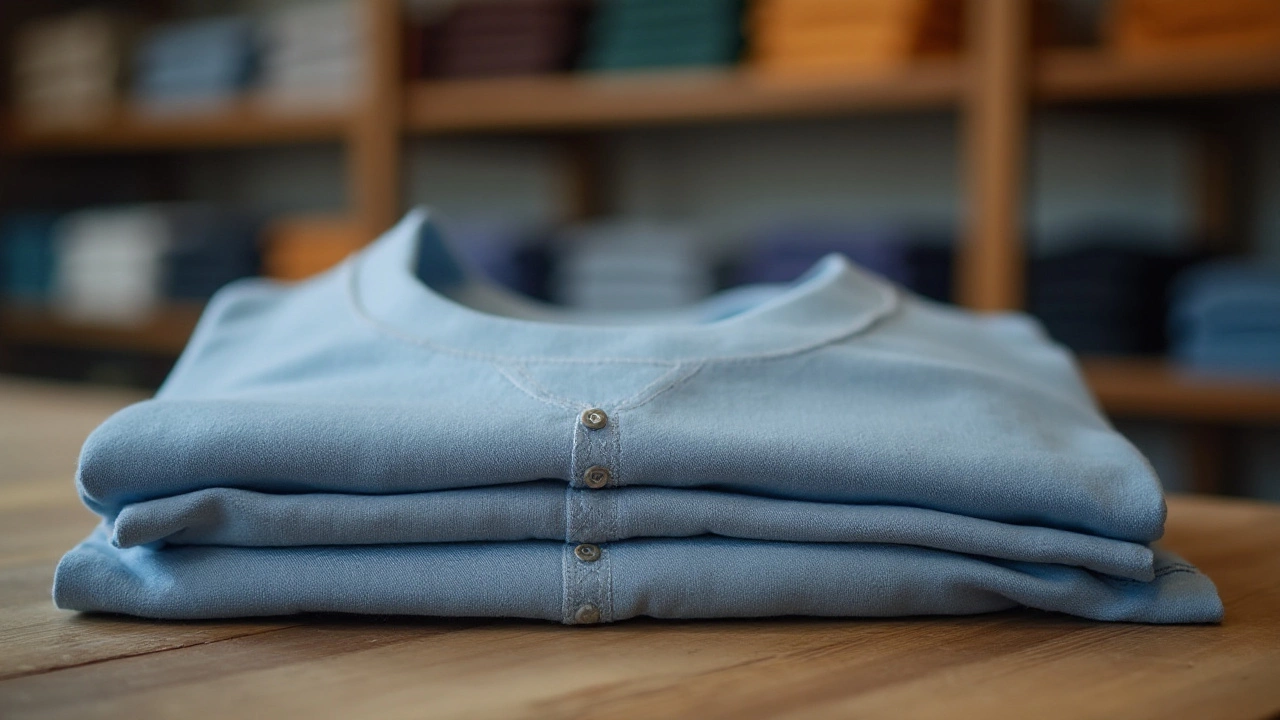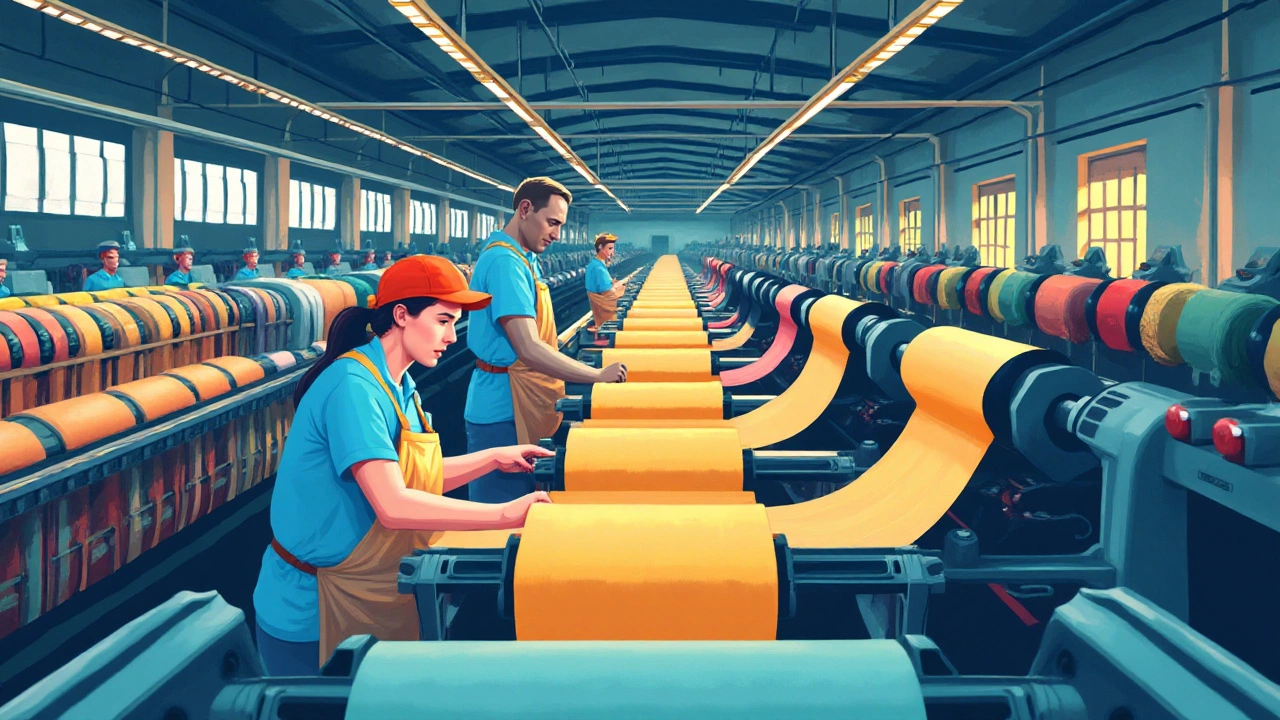In today's fast-paced world of fashion, not all t-shirts are created equal. While they may look similar at first glance, the quality can vary significantly, affecting both how they feel and how long they last. But how can you tell if you're looking at a t-shirt that will stand the test of time?
Understanding the quality of a t-shirt involves more than just appearance; it's about the fabric, the stitching, and even where it's made. A high-quality t-shirt isn't just about style; it's about finding the perfect blend of comfort and durability, crafted to withstand wear and washing.
Join us on a journey where we'll uncover the secrets behind identifying quality t-shirts. From fabric selection to the fine points of tailoring, let's explore what sets the best apart from the rest and ensures you make the best investment in your wardrobe.
- Fabric Types: The Foundation of Quality
- Importance of Stitching and Seams
- Weight and Finish: What They Mean
- Attention to Details: Tags, Labels, and Care
- The Origin of Production Matters
- Smart Shopping Tips for High-Quality T-Shirts
Fabric Types: The Foundation of Quality
When it comes to determining the quality of a t-shirt, the fabric is genuinely the cornerstone of assessment. It's often the first aspect that savvy shoppers feel and examine. A high-quality fabric not only ensures comfort but also durability, maintaining its shape and sheen after numerous washes. Cotton is traditionally the most popular fabric favored for t-shirts thanks to its natural properties. Among its many types, Egyptian and Pima cotton are renowned for their softness and strength. These fibers are longer, making the fabric less prone to fraying or pilling, and they hold dye better, keeping colors bright over time. Another fabric type is cotton blends, which combine the comfort of cotton with synthetic materials like polyester. This blend can enhance wrinkle resistance and improve longevity.
In some premium brands, we find fabrics like organic cotton, which is becoming increasingly popular among eco-conscious consumers. This fabric is grown without harmful chemicals, promoting sustainability and often boasting better quality since it undergoes less processing. On the tech-savvy front, moisture-wicking materials crafted from synthetic fibers offer an excellent solution for athletes or workouts. These fabrics draw sweat away from the body, aiding comfort in high-energy activities. Look for terms like Dri-FIT and Coolmax, which indicate the use of advanced fabric technology.
As Vivienne Westwood famously said, "Buy less, choose well, make it last." This ethos carries perfectly into selecting a quality t-shirt.
It's interesting to note how each material fits into different scenarios and usage. Linen, for instance, is another fabric occasionally used in summer collections. It's breathable and cool, perfect for hot climates, but its wrinkle-prone nature means it requires careful handling and maintenance. Rayon, on the other hand, is a fabric designed as a silk alternative, revered for its sheen and ability to absorb dyes wonderfully. However, it's less durable and can easily lose its original shape if not handled properly. Nowadays, a growing trend is the use of sustainable fibers like Tencel, made from wood pulp. It possesses a combination of strength, softness, and eco-friendliness, making it an emerging favorite in the high-quality t-shirt market.
Importance of Stitching and Seams
When it comes to evaluating a t-shirt, stitching and seams play an essential role in determining its quality and longevity. At first glance, these details might appear trivial, but they are the backbone of a garment's structure, ensuring it holds its shape and withstands regular wear and washing. The type of stitch used and the attention to detail in the seams can differentiate a high-quality t-shirt from a mass-produced, short-lived piece. Double stitching, particularly, is a hallmark of a durable t-shirt, providing additional reinforcement at key stress points like the neckline, cuff, and hem. Ensuring these stitches are straight and uniform reveals a commitment to quality in construction.
There are several stitches utilized in the making of t-shirts, and understanding each can aid in recognizing quality. For instance, the use of an overlock stitch provides a clean finish and prevents the fabric from unraveling. This stitch is a sign that the manufacturer has invested both time and resources into producing a well-crafted garment. A key indicator of poor quality is loose threads or crooked stitching, which can affect the t-shirt's durability. Expert tailors often check for consistent stitch density, indicating even tension in the thread, which contributes to the garment’s integrity and resilience.
Seams play a critical role beyond just connecting pieces of fabric; they add to the aesthetic appeal and fit of the garment. Side seams, in particular, help the t-shirt maintain its shape over time. Tubular t-shirts, while cheaper to make due to the absence of side seams, often lose their shape with repeated washing and wearing. On the other hand, a well-seamed shirt offers better fit and complements the body's natural contours. Observing the seam's finish using techniques like flat-felled seams or other intricate methods is a clear sign of a thoughtfully made garment. As a rule of thumb, investing in t-shirts with well-constructed seams can be a wise choice for both comfort and style retention.
Industry experts often highlight the impact of meticulous stitching on a garment's quality. As fashion designer Karl Lagerfeld once noted,
"The seam separates the men from the boys."This statement reinforces the notion that fine details such as seams can significantly enhance the elegance and longevity of a t-shirt, establishing it as more than just a basic clothing piece. Such attention to detail illustrates the difference between a garment made to last and one that will quickly wear out.

Weight and Finish: What They Mean
When it comes to identifying high-quality t-shirts, understanding the weight and finish of the fabric is crucial. These elements not only influence the t-shirt’s appearance but also its durability and comfort. The weight of a t-shirt is typically measured in grams per square meter (GSM), and it indicates the thickness of the material. A higher GSM often means a thicker, more substantial fabric, which can offer better durability and greater opacity. This helps in maintaining the t-shirt's shape over time, resisting wear and tear, and reducing the likelihood of seam stress. However, opting for heavier material may compromise ventilation, making it less suitable for warmer climates or as an undergarment. Lighter fabrics, often found in t-shirts with a GSM of under 150, provide a breezy feel, ideal for summer wear or layering.
The finish, on the other hand, refers to the surface characteristics of the fabric. A high-quality t-shirt typically boasts a smooth, even finish, free from imperfect textures or inconsistencies. This aspect of finish also relates to how the fabric feels against the skin and its visual appeal. Some manufacturers employ special techniques, such as mercerization, to enhance the fabric's luster and smoothness, which adds a touch of elegance to a simple garment. Finish finishes can vary from soft, matte-like appearances to glossy, silk-like surfaces. Each finish type provides a unique tactile experience and appearance, influencing your choice based on personal preference and intended wear occasion.
According to renowned textile expert Dr. Jane Hamilton, 'Understanding fabric weight and finish are essential steps in recognizing quality garments. The right combination ensures comfort while spotlighting the craftsmanship behind the t-shirt.'
While examining weight and finish, one must consider personal use and care preferences. Heavier fabrics tend to withstand frequent washes without losing shape or color, proving cost-effective in the long term. Conversely, lighter t-shirts may need delicate washing methods to preserve their quality. Choosing a finish that can withstand your laundering routine will also maintain the fabric's look and feel. Paying attention to these subtleties helps in understanding what you're investing in and whether it aligns with your lifestyle. Whether you're seeking a robust, durable t-shirt or a light, understated staple, knowledge about t-shirt fabric weight and finish empowers smarter purchasing decisions.
Attention to Details: Tags, Labels, and Care
When it comes to purchasing a high-quality t-shirt, often the most telling signs are in the subtleties. One of these subtle but important aspects is the t-shirt's tag or label. These small details, typically sewn inside the neckline or side seam, offer a treasure trove of information. A well-made t-shirt will feature labels that not only offer an understanding of the fabric composition but will also provide clear washing instructions. For example, if the label mentions a significant percentage of organic cotton, it's typically a nod towards a more premium product, offering superior softness and longevity. Well-constructed garments won't skimp on the label quality; if it feels soft and is securely attached without loose threads, it's usually indicative of the garment's overall craftsmanship.
Another critical component is the care instructions laid out on these labels. These guidelines might seem trivial, but they ensure that your t-shirt maintains its shape, color, and comfort through multiple wears and washes. Proper care instructions will include not just machine settings but also advice on whether to tumble dry or air dry. Interestingly, a Consumer Reports survey highlights that garments treated with care according to labels tend to last nearly 20% longer, underscoring the value of heeding these small details. Paying attention to the care label means respecting the garment's materials and not exposing them to harsh conditions that might shorten their life.
The minute elements of the tags and labels also hint at the brand's attention to detail. Heritage or boutique brands often take pride in using bespoke labels as a signature mark of quality. These can be subtly stitched with the brand's logo or even provide quirky, endearing messages that enhance the garment's personality. As an amusing touch, some high-end t-shirts even include a hidden, smaller label with brand stories or sustainability promises, showcasing their commitment to transparency. An intricate label can thus transform a basic t-shirt into something more intimate and cherished by connecting you not just to the garment, but to its makers and ethos.
Finally, beyond just what is printed on them, tags and labels are often an indicator of where the shirt was manufactured. High-quality production often occurs in regions renowned for meticulous crafting techniques, like Italy or Japan, where artisanal skill and quality control result in impeccable standards. Look out for indications of ethical manufacturing and whether the brand adopts fair-trade practices. Many modern consumers choose their garments not just based on aesthetics or price, but also on these ethical considerations. Brands offering transparent insights into their production journey hold a distinct edge as they align with the growing conscious consumerism trend.

The Origin of Production Matters
When it comes to identifying a high-quality t-shirt, understanding where your garment was produced can tell you a lot about its potential durability and the standards it was held to during manufacturing. Different countries have varying reputations for the quality and ethics of their garment industries. For instance, Italian-made t-shirts are often associated with luxury and refinement due to Italy's rich history in textile production. Countries like Japan and Portugal are also known for their meticulous attention to detail and the use of advanced fabric technology in garment manufacturing. Meanwhile, regions like Bangladesh, India, and Vietnam are often highlighted in discussions on apparel production chains, but it's crucial to know which factories maintain high ethical and quality standards to ensure your purchase supports sustainable and fair practices.
The country of origin can influence the materials used and the processes implemented in production. For example, t-shirts made in countries with stringent environmental regulations may be more likely to use organic cotton or other eco-friendly materials. A noteworthy trend seen in the past few years is the shift towards ethical fashion, where transparency in production practices plays a crucial role. Consumers are increasingly motivated to buy from brands that can guarantee fair wages and safe working conditions. "Choosing to buy from brands that prioritize ethical production not only supports the movement for fair labor but also assures you of a garment built to last," notes fashion analyst Suzy Menkes. Let’s not forget the rising demand for locally produced t-shirts, advocating for 'made in your country' labeling, which supports local economies and often reduces the carbon footprint associated with shipping goods worldwide.
If you’re aiming to ensure your t-shirt purchase is both high-quality and ethically made, consider researching brands that disclose their production practices. Many now provide detailed information about their factories on their websites, complete with certifications like Fair Trade or WRAP (Worldwide Responsible Accredited Production). This transparency not only boosts consumer confidence but fosters a more ethical industry standard. Quality clothing isn’t just about longevity—it's about supporting a system that values workers and the planet. Look for brands with a commitment not only to fabric excellence and stylish design but also a promise of responsible sourcing and manufacturing. This comprehensive approach will help you invest in t-shirts that reflect your values and stand the test of time.
Smart Shopping Tips for High-Quality T-Shirts
Selecting a high-quality t-shirt can seem daunting, but with a few savvy strategies, you can become a seasoned shopper. First, pay close attention to the fabric composition. Fabrics like 100% cotton, especially combed or ring-spun, provide a luxurious feel and superior breathability. These fabrics endure since they resist pilling and hold dye well, ensuring vibrant colors after countless washes. Don’t shy away from blends too; a little bit of polyester can add durability and reduce wrinkling.
Another important factor is the garment’s weight. High-quality t-shirts often boast a dense and even weight across the fabric. A substantial weight suggests durability, yet pay attention to the feel so it's not too heavy for your liking. Look for finishes that offer softness and stretch without losing shape, ensuring comfort and longevity. Pull the fabric slightly; well-made materials return to their shape quickly, indicating resilience.
Invest in Craftsmanship
Dedicate time to scrutinize the craftsmanship of the t-shirt. Quality shows in the stitches; examine the seams and ensure they are smooth and tight. Double-stitching or reinforcement in areas prone to stress, such as shoulders and necklines, marks superior quality clothing. A good t-shirt will not have loose threads or sloppy stitching. Check how the sleeve and bottom hems are sewn; secure hems mean the t-shirt is less likely to unravel.The quality of material and construction will determine longevity. – Fashion Expert, Charles Frederick Worth
Examine Tags and Labels
Understand the implications of care instructions on tags; they are indicative of the fabric blend and maintenance required. Machine washable tags suggest durability, but look out for recommendations like ‘cold wash, hang dry’ to prevent unwanted shrinkage and preserve color. Pay attention to the manufacturing origin. Brands based in countries with stringent quality control, like those in Europe and Japan, often ensure better standards.Make Informed Choices
Finally, becoming an informed shopper means researching brands known for their high-quality standards, reviews, and transparency about their material sourcing. Well-established brands or dedicated ethical companies often provide excellent quality. While shopping, ask yourself: Does this align with my requirements of style, sustainability, and comfort? In an era where green fashion becomes significant, opting for eco-friendly brands could not only benefit you but also the planet.| Fabric Type | Quality Indicators |
|---|---|
| 100% Cotton | Soft, breathable, durable |
| Cotton-Polyester Blend | Resilient, less wrinkling |
| Organically Grown | Eco-friendly, gentle on skin |

